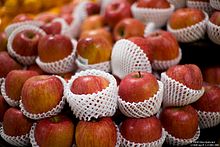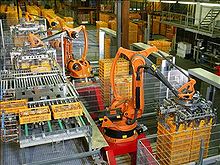
Food Packaging requires protection, tampering resistance, and special physical, chemical, or biological needs. It also shows the product that is labeled to show any nutrition information on the food being consumed.
| | It is critical to maintain Food safety during processing, packaging, storage, logistics (including cold chain), sale, and use. However, in the recent years reduced packaging and sustainable packaging are becoming more frequent. The motivations can be government regulations, consumer pressure, retailer pressure, and cost control. (Reduced packaging often saves packaging costs.) |
In the UK, A Local Government Association survey produced by the British Market Research Bureau, compared a range of outlets to buy 29 common food items, found that small local retailers and market traders "produced less packaging and more that could be recycled than the larger supermarkets.
Food packaging types
The above materials are fashioned into different types of food packages and containers such as:
Primary packaging is the main package that holds the food that is being processed. Secondary packaging combines the primary packages into one box being made. Tertiary packaging combines all of the secondary packages into one pallet.
| Packaging type | Type of container | |
| Aseptic processing | Primary | Liquid whole eggs |
| Plastic trays | Primary | Portion of fish |
| Bags | Primary | Potato chips |
| Boxes | Secondary | Box of Cola |
| Cans | Primary | Can of Tomato soup. |
| Cartons | Primary | Carton of eggs |
| Flexible packaging | Primary | Bagged salad |
| Pallets | Tertiary | A series of boxes on a single pallet used to transport from the manufacturing plant to a distribution center. |
| Wrappers | Tertiary | Used to wrap the boxes on the pallet for transport. |
There are also special containers that combine different technologies for maximum durability:
- Bags-in-boxes (used for soft drink syrup, other liquid products, and meat products)
- Wine box (used for wine)
Packaging machines
| A choice of packaging machinery includes technical capabilities, labor requirements, worker safety, maintainability, serviceability, reliability, ability to integrate into the packaging line, capital cost, floorspace, flexibility (change-over, materials, etc.), energy usage, quality of outgoing packages, qualifications (for food, phamaceuticals, etc.), throughput, efficiency, productivity, ergonomics, etc. |
Trends in food packaging
Numerous reports industry associations agree that use of smart indicators will increase. There are a number of different indicators with different benefits for food producers, consumers and retailers.
Temperature recorders
Temperature recorders are used to monitor products shipped in a cold chain and to help validate the cold chain. Digital temperature data loggers measure and record the temperature history of food shipments. They sometimes have temperatures displayed on the indicator or have other output (lights, etc.): The data from a shipment can be downloaded (cable, RFID, etc.) to a computer for further analysis. These help identify if there has been temperature abuse of products and can help determine the remaining shelf life.[5] They can also help determine the time of temperature extremes during shipment so corrective measures can be taken.
reference: wikipedia
Written by Nicolas Yang







